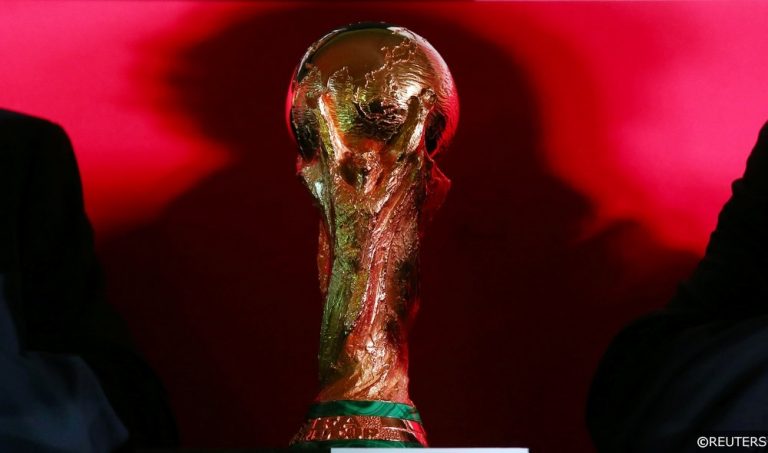
Born in the south east of Ireland, Simon put his life-long love of football to good use when he started a successful independent blog in 2010. That opened up an alternative route to a career in journalism, and having had work published across a number of sites and publications, Simon joined the staff at Spotlight Sports Group in 2018.
The World Cup is the most easily recognisable trophy in sport. The highly coveted hunk of precious metal has history as colourful and controversial as the tournament it symbolises.
Since the first World Cup tournament 1930, two different trophies have been awarded to the winning nation. The first trophy, which came from the imagination of Parisian sculptor Abel Lafleur in 1929, was originally given the name “Victory”.
Its design incorporated a depiction of the Greek Goddess Nike holding aloft an empty vessel. The silver sterling and gold plated idol was later renamed “The Jules Rimet Trophy” in honour of the former FIFA president of the same name. Rimet had been instrumental in initiating the first World Cup tournament in Uruguay.
Uruguayan captain José Nasazzi became the first player to lift the Jules Rimet trophy in 1930, though the trophy crossed the Atlantic four years later, landing in Italy and staying there for twelve years. Under the protection of the Italians, Lafleur’s design escaped capture by the Nazis during the Second World War.
Read more: Weird World Cup: 10 of The Strangest Stories in World Cup History
When West Germany won the Cup in 1954, rumour has it that they kept the original trophy and fabricated a replica to send on to the next competition four years later in Sweden. Some historians point to quite obvious differences between the ’54 and ’58 trophies, with photographic evidence hinting that something underhand had taken place.
Nevertheless, the Jules Rimet (or Jules Rimet Mk II) went back to South America in 1958 with Brazil, where it stayed there for another four years after the Brazilians defended their title in Chile in 1962.
Trophy Theft

The Queen presents the 1966 World Cup to England Captain, Bobby Moore. By National Media Museum from UK [No restrictions], via Wikimedia Commons
When it returned to Europe for the 1966 World Cup in England, the Jules Rimet Trophy was stolen a few months prior to the tournament. The brazen thieves made off with the Cup after they liberated it from a display case at a Stamp Expo at Westminster Central Hall.
After a series of events that wouldn’t look out of place in a Guy Ritchie movie (including ransom notes, Police Flying Squads and a used car dealer), the investigation came to a dead end with the trophy still missing.
However, just a week after it had been stolen, the Jules Rimet Trophy was found wrapped in newspaper on a street in South East London by a dog named Pickles. David Corbett had been out walking his dog when it began sniffing at the unusual parcel near his own hedge.
England of course, went on to lift the World Cup for the only time in their history that year. Geoff Hurst might have scored the goals, but Pickles is the real hero of the story.
Sports writer Simon Kuper added his own layer of intrigue to the Pickles story when researching the circumstances surrounding the World Cup’s disappearance and rediscovery.
“Less well known is that after Pickles’ discovery, England’s Football Association secretly asked the jeweller George Bird to make a replica. Bird produced a gilded bronze trophy that looked just like the cup Pickles had found.”
“Now there were two Rimets, or perhaps three if the original had indeed disappeared in the 1950s. What’s even more intriguing is that after Bird’s death in 1995, his replica Rimet was sold at auction for a staggering £254,500. The ‘anonymous’ bidder? FIFA.”
“In 2006 I asked FIFA if it had thought Bird’s trophy was the real Rimet. I didn’t expect a reply,” said Kuper. “But FIFA’s media office emailed back [and said], ‘Yes, FIFA took the decision to buy this trophy as it was thought to be the original one.”
The Jules Rimet’s rotten luck doesn’t stop there.
After Brazil won the World Cup for the third time in 1970, FIFA allowed them to keep the Jules Rimet trophy permanently to honour their achievement. However, thirteen years later in 1983 the trophy was stolen for a second time while on display in Brazil, although this time it was never recovered.
The Brazilian authorities postulated that the trophy had likely been melted down and sold as gold bullion, though the evidence they put forward was far from convincing. Their story did allow them to draw a line under their investigation however, ambiguous as it was.
Read more: Top 10 World Cup Goals of All Time
A Trophy Reborn

West Germany celebrate with the 1974 World Cup. By Bert Verhoeff / Anefo [CC0], via Wikimedia Commons
Anyway, let’s rewind a little. In 1971 after FIFA had allowed the “original” trophy to stay in Brazil, they decided to commission a complete redesign of the Cup. Taking out newspaper adverts across the globe, they put out to public tender the request for a new World Cup trophy.
53 potential designs from 25 nations were submitted to FIFA, but football’s international association were captivated most by the work of Italian sculptor Silvio Gazzaniga.
From a dusty workshop in the artist’s quadrant of Milan, Gazzaniga designed a 36.5 cm tall trophy, made up of 18 karats of pure gold. Its 13cm diameter base was made of two layers of Malachite. The trophy weighed a little over 6kg and depicted an image of the earth held aloft by two human figures.
Originally, it was claimed the trophy was made of solid gold, however given its dimensions, the cup would weigh a massive 70 to 80kg if it was indeed solid. It’s much more likely that the trophy is in fact hollow.
Gazzaniga said of his work “To create a universal symbol relating to sport and the harmony of world sport, I was inspired by two fundamental images: those of a triumphant athlete and of the world. I wanted to create a dynamic representation of an accomplishment that could express harmony, simplicity and peace simultaneously.”
Bizarrely, only Heads of State and previous winners are allowed to touch the World Cup trophy. Fans can have their photo taken with the Cup, but are forbidden from putting their hands on it. I guess the thieves ruined it for everyone.
Using his World Cup design as a springboard, Gazzaniga went on to fabricate the UEFA Cup trophy in 1972 and the UEFA Super Cup trophy a year later. The sculptor was awarded the city of Milan’s highest honour, the “Certificate of Merit of the Ambrogino d’Oro” in 2003.
As luck would have it, Franz Beckenbauer became the first international captain to lift Gazzaniga’s trophy in 1974, though it’s unclear whether the West German’s again pocketed another original and sent a knock-off to Argentina four years later.
At this summer’s World Cup in Russia, the competing nations will be vying to become the 12th side to lift the trophy since it was reborn in 1971. They will be battling it out for the chance to lift a piece of history alongside the opportunity to make some history of their own.
Follow Free Super Tips on Twitter to stay up to date with our daily tips and predictions or browse more football content on our website:


